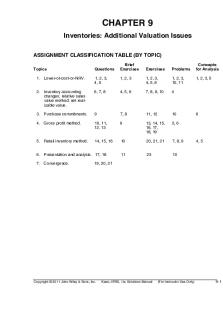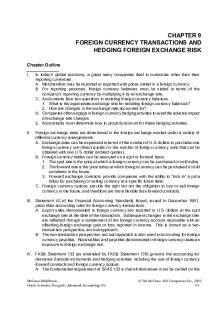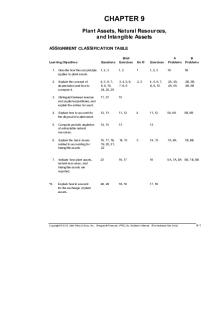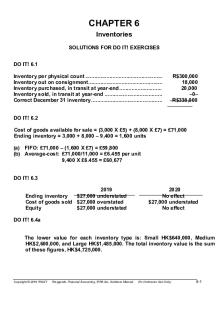Solution Manual Advanced Accounting 4e Jeter Ch09 PDF

| Title | Solution Manual Advanced Accounting 4e Jeter Ch09 |
|---|---|
| Course | Accounting |
| Institution | Đại học Hà Nội |
| Pages | 62 |
| File Size | 927.1 KB |
| File Type | |
| Total Downloads | 721 |
| Total Views | 1,074 |
Summary
To download more slides, ebook, solutions and test bank, visit CHAPTER 9 ANSWERS TO QUESTIONS 1. Constructive retirement refers to the purchase of an outstanding bonds from outsiders. From a consolidated entity viewpoint, the consolidated entity has retired its outstanding debt, and is thus treated ...
Description
CHAPTER 9 ANSWERS TO QUESTIONS 1.
Constructive retirement refers to the purchase of an affiliate's outstanding bonds from outsiders. From a consolidated entity viewpoint, the consolidated entity has retired its outstanding debt, and is thus treated as an early extinguishment of debt. The difference between the carrying value of the bonds and the purchase price to the purchasing affiliate is the constructive gain or loss on bond retirement.
2.
The gain or loss is composed of two elements: (1) the discount or premium on the books of the issuer, and (2) the discount or premium paid by the purchaser. Discounts and/or premiums on the books of the two affiliates will be subsequently amortized to income. The cumulative effect on income of the amortization of the discount or premium by the two affiliates is equal to the constructive gain or loss.
3.
The allocation of a gain or loss would be made to each affiliate based on whether the affiliate paid or issued the bonds for more or less than book value or par value. A discount (premium) to the issuer would be allocated to the issuing company as a loss (gain), whereas a discount (premium) to the purchasing affiliate would be a gain (loss). The sum of the two is the total constructive gain or loss.
4.
Support for allocating the total gain or loss to the issuing company is based on the contention that the purchasing affiliate is acting as an agent for the issuing company. Since both companies are under the control of the management of the parent company, the bonds could be transferred to the issuing company. Thus, the purchase is in substance a retirement by the issuing company.
5.
The noncontrolling interest is affected by the portion of the constructive gain or loss allocated to the subsidiary. Because the loss is recognized in the consolidated income statement in the year the bonds are purchased, a discount or premium amortization related to bonds that is made subsequent to the purchase is added back or is subtracted from the subsidiary's reported income. Such adjustments will increase or decrease the noncontrolling interest in the income of the subsidiary.
6.
a. Investor Company Purchase price Par value Constructive gain
$338,000 350,000 $ 12,000
b. Investee Company Carrying value Par value Constructive gain
$360,000 350,000 $ 10,000
7.
The outside party (the maker of the note) is primarily liable; and Affiliate Y, who discounted the note with an outside party, is contingently liable for it.
8.
Stock dividends are viewed as a distribution of the earliest earnings accumulated in the retained earnings account.
9.
The retained earnings balance at the date of acquisition is reduced since the issuance of a stock dividend is viewed as a distribution of the earliest earnings accumulated.
9-1
10. A memorandum entry is required to recognize the number of shares received since a dividend in stock is not considered income to the recipient. 11. In the year of declaration, one additional elimination entry is required to eliminate the effects of the dividend. In subsequent periods the amounts of this entry are combined with the investment elimination entry. 12. Preferred stock of a controlled corporation held by others not in the controlled group represents noncontrolling interest in the controlled corporation. The rights of these shareholders depend on the stock's preference; possibilities are an interest in net assets, earnings, and retained earnings of the controlled corporation. 13. Excess of cost over book value is debited to Other Contributed Capital or to Retained Earnings; excess of book value acquired over cost is credited to Other Contributed Capital. 14. The preferred stock's cumulative preference would increase the net loss allocable to the common stockholders. SOLUTIONS TO BUSINESS ETHICS CASE The responsibility of the management of the company is to present accurately the financial statements to the shareholders and investors. Accordingly if an error is detected in the books, it should be rectified as soon as it is discovered so that shareholders and investors are not misled. Intercompany sales are eliminated in the consolidating process. Failure to do so is a material omission, particularly when the inventories in question have not been sold to outsiders but remain in the inventories of the consolidated entity. You should not succumb to the pressure exerted by the manager of the subsidiary. SOLUTIONS TO EXERCISES Exercise 9-1 Part A
Part B
Cost of bond investment Par value Unamortized discount ($60,000 (16/20)) Carrying value of bonds Percent of bonds purchased Carrying value of bonds purchased Total constructive loss
$820,000 $1,000,000 48,000 952,000 .80 761,600 $58,400
Pacelli Company
Salez Company
Carrying value of bonds purchased $761,600 Par value 800,000 Constructive loss $ 38,400
Cost of bond investment $820,000 Par value of bonds purchased 800,000 Constructive loss $ 20,000
9-2
Part C June 30 and December 31, 2012 Pacelli Company Interest Expense (10%)(1/2)($1,000,000) Cash
50,000 50,000
Interest Expense Discount on Bonds Payable $60,000 / 20 interest periods = $3,000
3,000 3,000
Salez Company Cash Interest Income ($800,000)(1/2)(10%)
40,000 40,000
Interest Income Investment in Pacelli Company Bonds $20,000 premium /16 periods = $1,250
1,250 1,250
Part D Note: We have provided solutions assuming the use of any of the three methods. Since the schedules start with the same reported income of Pacelli under all three methods, this results in three different consolidated net income numbers. 2011
Partial Complete Cost Method Equity Method Equity Method $260,000 $260,000 $260,000 48,000 112,000
Reported net income - Pacelli Less: Dividend income ($60,000)(.80) Less: Equity Income ($140,000)(.80) Less: Adjusted Equity Income ($112,000-38,400-(80% of 20,000)) Net income from independent operations - Pacelli 212,000 Less: Constructive loss on bond retirement 38,400 Pacelli's contribution to consolidated income 173,600 Reported net income of Salez $140,000 Less: Constructive loss on bond retirement 20,000 Salez's contribution to consolidated income 120,000 .80 96,000 Controlling interest in consolidated net income $269,600 Noncontrolling interest in consolidated income ($120,000 .20) $24,000
9-3
148,000 38,400 109,600
57,600 202,400 38,400 164,000
96,000 $205,600
96,000 $260,000
$24,000
$24,000
Exercise 9-1 (continued) Partial Complete 2012 Cost Method Equity Method Equity Method Reported net income - Pacelli $280,000 $280,000 $280,000 Less: Dividend income ($60,000)(.80) 48,000 Less: Equity income ($190,000)(.80) 152,000 Less: Adjusted Equity income ($152,000 + $4,800 + (.80 $ 158,800 Net income from independent operations - Pacelli 232,000 128,000 121,200 Add: Constructive loss recorded* 4,800 4,800 4,800 Pacelli's contribution to consolidated income 236,800 132,800 126,000 Reported net income of Salez $190,000 Add: Constructive loss recorded** 2,500 Salez's contribution to consolidated income 192,500 0.80 154,000 154,000 154,000 Controlling interest in consolidated net income $390,800 $286,800 $280,000 Noncontrolling interest in consolidated income ($192,500 .20)
$38,500
$38,500
$38,500
*($3,000 .80) = $4,800 or constructive loss divided by 8 years = $38,400/8 years = $4,800 ** Constructive loss divided by 8 years = $20,000/8 = $2,500 Exercise 9-2 December 31, 2011 Cost and Partial Equity 38,400 38,400
Loss on Constructive Retirement of Bonds Discount on Bonds Payable Loss on Constructive Retirement of Bonds Investment in Pacelli Company Bonds
20,000
Bonds Payable Investment in Pacelli Company Bonds
800,000
Complete Equity 38,400 38,400 20,000
20,000
20,000 800,000
800,000
800,000
December 31, 2012 Beginning Retained Earnings - Pacelli Company Discount on Bonds Payable
38,400 38,400
Investment in Salez Discount on Bonds Payable Discount on Bonds Payable Interest Expense (($3,000 + $3,000)
38,400 38,400 4,800 .80)
4,800 4,800
9-4
4,800
Exercise 9-2 (continued) Cost and Partial Equity 16,000 4,000 20,000
Beginning Retained Earnings - Pacelli Noncontrolling Interest Investment in Pacelli Company Bonds Investment in Salez Noncontrolling Interest Investment in Pacelli Company Bonds
16,000 4,000 20,000
Investment in Pacelli Company Bonds Interest Income ($1,250 + $1,250) Interest Income Interest Expense Nominal interest of $100,000
Complete Equity
2,500
2,500 2,500
80,000
2,500 80,000
80,000
80,000
.80 = $80,000
Bonds Payable Investment in Pacelli Company
800,000
800,000 800,000
800,000
December 31, 2013 Cost and Partial Equity 38,400 38,400
Beginning Retained Earnings - Pacelli Discount on Bonds Payable Discount on Bonds Payable Beginning Retained Earnings - Pacelli Interest Expense (($3,000 + $3,000) .80)
9,600 4,800 4,800
Investment in Salez Discount on Bonds Payable Discount on Bonds Payable Investment in Salez Interest Expense (($3,000 + $3,000)
Complete Equity
38,400 38,400 9,600 4,800 4,800
.80)
Beginning Retained Earnings - Pacelli –Noncontrolling Interest Investment in Pacelli Company Bonds
16,000 4,000
Investment in Pacelli Company Bonds Beginning Retained Earnings - Pacelli Noncontrolling Interest Interest Income ($1,250 + $1,250)
5,000
20,000 2,000 500 2,500
9-5
Exercise 9-2 (continued) Cost and Partial Equity Investment in Salez Noncontrolling Interest Investment in Pacelli Company Bonds
16,000 4,000 20,000
Investment in Pacelli Company Bonds Investment in Salez Noncontrolling Interest Interest Income ($1,250 + $1,250) Interest Income Interest Expense Nominal interest of $100,000
Complete Equity
5,000 2,000 500 2,500 80,000
80,000 80,000
80,000
.80 = $80,000
Bonds Payable Investment in Pacelli Company
800,000
800,000 800,000
800,000
Exercise 9-3 Part A Cost of bond investment ($510,000 .90) Par value Unamortized premium ($42,500 ) Carrying value of bonds Percent of bonds purchased (510/850) Carrying value of bonds purchased Total constructive gain Part B Fairfield Company Cost of bond investment Par value Constructive gain
$459,000 510,000 $ 51,000
$459,000 $850,000 34,000 884,000 .60 530,400 $71,400 Weber Company Carrying value of bonds purchased Par value Constructive gain
$530,400 510,000 $ 20,400
Part C June 30 and December 31, 2012 Fairfield Company Cash ($510,000
.10
6 ) 12
25,500
Interest Income
25,500
Investment in Weber Company Bonds Interest Income $51,000 / 8 periods = $6,375
6,375 6,375
9-6
Exercise 9-3 (continued) Weber Company Interest Expense Cash ($850,000
42,500 .10
6 ) 12
42,500
Premium on Bonds Interest Expense $34,000 / 8 periods = $4,250
4,250 4,250
Part D Note: We have provided solutions assuming the use of any of the three methods. Since the schedules start with the same reported income of Fairfield under all three methods, this results in three different consolidated net income numbers. 2011
Partial Complete Cost Method Equity Method Equity Method $275,000 $275,000 $275,000 54,000 171,000
Reported net income - Fairfield Less: Dividend income ($60,000 .90) Less: Equity income ($190,000)(.90) Less: Adjusted Equity income (171,000+51,000 + .9(20,400)) Net income from independent operations – Fairfield Add: Constructive gain on bond retirement Fairfield's contribution to consolidated income Reported net income - Weber $190,000 Add: Constructive gain on bond retirement 20,400 Weber's contribution to consolidated income 210,400 .90 Controlling interest in consolidated net income Noncontrolling interest in consolidated income ($210,400 .10)
9-7
221,000 51,000 272,000
104,000 51,000 155,000
240,360 34,640 51,000 85,640
189,360 $461,360
189,360 $344,360
189,360 $275,000
$21,040
$21,040
$21,040
Exercise 9-3 (continued) 2012
Partial Complete Cost Method Equity Method Equity Method $350,000 $350,000 $350,000 72,000 202,500
Reported net income - Fairfield Less: Dividend income ($80,000 .90) Less Equity income ($225,000)(.90) Less: Adjusted Equity income ($202,500 - $12,750 - (.9)5,100) Net income from independent operations - Fairfield Less: Constructive gain recorded* Fairfield's contribution to consolidated income Reported net income - Weber $225,000 Less: Constructive gain recorded** 5,100 Weber's contribution to consolidated income 219,900 .90 Controlling interest in consolidated net income
278,000 12,750 265,250
147,500 12,750 134,750
185,160 164,840 12,750 152,090
197,910 $463,160
197,910 $332,660
197,910 $350,000
$21,990
$21,990
$21,990
Noncontrolling interest in consolidated income ($219,900 .10) * $6,375
2 = $12,750 or $51,000/4 periods = $12,750
**$4,250
.60 = $2,550; $2,550
2 = $5,100
Exercise 9-4 December 31, 2011 Premium on Bonds Payable ($34,000 .60) Constructive Gain on Bond Retirement
Cost and Partial Equity 20,400 20,400
Investment in Weber Company Bonds Constructive Gain on Bond Retirement Bonds Payable Investment in Weber Company Bonds
51,000
Complete Equity 20,400 20,400 51,000
51,000 510,000
510,000 510,000
9-8
51,000 510,000
Exercise 9-4 (continued) December 31, 2012 Investment in Weber Co. Bonds Beginning Retained Earnings - Fairfield
Cost and Partial Equity 51,000 51,000
Investment in Weber Co. Bonds Investment in Weber Co. Stock
51,000 51,000
Interest Income ($6,375 Investment in Weber Company Bonds
12,750
Premium on Bonds Payable Beginning Retained Earnings - Fairfield Noncontrolling Interest
20,400
12,750 12,750
12,750
18,360 2,040
Premium on Bonds Payable Investment in Weber Co. Stock Noncontrolling Interest
20,400 18,360 2,040
Interest Expense (($4,250 2) .60) Premium on Bonds Payable
5,100
5,100 5,100
Interest Income Interest Expense Bonds Payable Investment in Weber Company Bonds
Complete Equity
51,000
5,100 51,000
51,000 510,000
510,000 510,000
9-9
51,000 510,000
Exercise 9-4 (continued) December 31, 2013 Investment in Weber Co. Bonds Beginning Retained Earnings - Fairfield
Cost and Partial Equity 51,000 51,000
Investment in Weber Co. Bonds Investment in Weber Co. Stock
51,000 51,000
Beginning Retained Earnings – Fairfield Interest Income ($6,375 Investment in Weber Company Bonds
12,750 12,750
12,750 25,500
Investment in Weber Co. Stock Interest Income ($6,375 Investment in Weber Company Bonds
12,750 12,750 12,750 25,500
Premium on Bonds Payable Beginning Retained Earnings - Fairfield Noncontrolling Interest
20,400 18,360 2,040
Premium on Bonds Payable Investment in Weber Co. Stock Noncontrolling Interest
20,400 18,360 2,040
Beginning Retained Earnings – Fairfield Noncontrolling Interest Interest Expense (($4,250 2) .60) Premium on Bonds Payable
4,590 510 5,100 10,200
Investment in Weber Co. Stock Noncontrolling Interest Interest Expense (($4,250 2) .60) Premium on Bonds Payable
4,590 510 5,100 10,200
Interest Income Interest Expense Bonds Payable Investment in Weber Company Bonds
Complete Equity
51,000
51,000 51,000
510,000
510,000 510,000
9 - 10
51,000 510,000
Exercise 9-5 1.
2.
Carrying value of debt - 1/2/2011 Less: Premium amortization - (($5,000/20) Carrying value of debt - 12/31/2011
2 periods)
$505,000 500 $504,500
Stated interest (30% of $500,000 .11) Add: Discount amortization (($10,000/20) Interest revenue
2 periods)
$16,500 1,000 $17,500
3.
Stated interest ($500,000 .11) Less: Premium amortization ($5,000/20)(2) Interest expense
4.
Cost of bond investment (1/2/2011) Add: Discount amortization * Investment account balance - 12/31/2011
* $500,000 par
$55,000 500 $54,500 $140,000 1,000 $141,000
30% less $140,000 paid divided by 10 years = $1,000
9 - 11
Exercise 9-5 (continued) 5.
Reported net income - Peoples Less: Dividend income ($90,000 .80) Independent net income Add: Constructive gain on bond retirement Less: Constructive gain recorded during year Contribution of Peoples to consolidated income Reported net income - Schmidt Less: amortization of difference between implied and book value - COGS Add: Constructive gain on bond retirement ($505,000 - $500,000) .30 = Less: Constructive gain recorded during year Income after adjustment for constructive gain
$300,000 72,000 228,000 10,000 (1,000) 237,000 $320,000 (60,000) 1,500 (150) 261,350 .80
Parent's share of adjusted income Controlling interest in consolidated net income
209,080 $446,080
Computation and Allocation of Difference between Implied and Book Value Acquired Parent Share $900,000 800,000
Purchase price and implied value Less: Book value of equity acquired: Difference between implied and book value Allocated to inventory Balance Goodwill Balance
6.
100,000 (48,000) 52,000 (52,000) -0-
Noncontrolling interest in consolidated income
$261,350
NonEntire Controlling Value Share 225,000 1,125,000 200,000 1,000,000 25,000 (12,000) 13,000 (13,000) -0-
125,000 (60,000) 65,000 (65,000) -0–
.20 = $52,270
Exercise 9-6 Part A Face (Par) value of note Interest ($60,000 .12 Maturity value Less: Discount ($61,800 Proceeds
) .13
)
9 - 12
$60,000 1,800 61,800 1,339 $60,461
Exercise 9-6 (continued) Part B
Notes Receivable Notes Receivable Discounted
Parent Company Dr (Cr) 60,000 (60,000)
Wyatt Corporation Dr (Cr) 60,000 (60,000)
*Elimination entry Notes Receivable Discounted Notes Receivable
Elimination Consolidated Entries Balances Debit Credit Dr (Cr) 60,000* 60,000 60,000* (60,000)
60,000 60,000
The results of th...
Similar Free PDFs
Popular Institutions
- Tinajero National High School - Annex
- Politeknik Caltex Riau
- Yokohama City University
- SGT University
- University of Al-Qadisiyah
- Divine Word College of Vigan
- Techniek College Rotterdam
- Universidade de Santiago
- Universiti Teknologi MARA Cawangan Johor Kampus Pasir Gudang
- Poltekkes Kemenkes Yogyakarta
- Baguio City National High School
- Colegio san marcos
- preparatoria uno
- Centro de Bachillerato Tecnológico Industrial y de Servicios No. 107
- Dalian Maritime University
- Quang Trung Secondary School
- Colegio Tecnológico en Informática
- Corporación Regional de Educación Superior
- Grupo CEDVA
- Dar Al Uloom University
- Centro de Estudios Preuniversitarios de la Universidad Nacional de Ingeniería
- 上智大学
- Aakash International School, Nuna Majara
- San Felipe Neri Catholic School
- Kang Chiao International School - New Taipei City
- Misamis Occidental National High School
- Institución Educativa Escuela Normal Juan Ladrilleros
- Kolehiyo ng Pantukan
- Batanes State College
- Instituto Continental
- Sekolah Menengah Kejuruan Kesehatan Kaltara (Tarakan)
- Colegio de La Inmaculada Concepcion - Cebu















